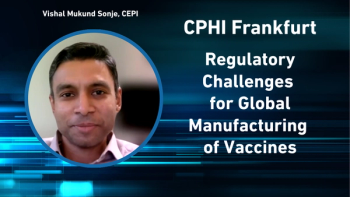
- Pharmaceutical Technology, October 2021 Issue
- Volume 45
- Issue 10
Public Trust in Medicine Quality as Public Health Challenges Emerge
Public health challenges have highlighted the need for agility in maintaining the quality of medicines.
Patient and consumer trust in medicines and public confidence in their quality and availability are critical for positive health outcomes. When systems for safeguarding medicines are weakened, public trust erodes.
Emerging public health challenges—including global vaccinations to stop the spread of COVID-19, proliferation of substandard and falsified medicines amid demand surges, and the detection of potentially cancer-causing nitrosamine impurities in some commonly-used medicines—have underscored the need for agility in maintaining the quality and consistency of medicines.
The US Pharmacopeia (USP) continues to build trust in medicines by creating scientific standards, tools, and solutions for industry, regulators, and practitioners that promote the ongoing availability and reliability of quality medicines in response to public health crises and other health needs.
An ongoing response to COVID-19
Hand sanitizers and methanol contamination. In 2020, the demand for alcohol-based hand sanitizers had surpassed its supply due to the rapidly evolving COVID-19 pandemic. As shortages of hand sanitizer became widely reported, compounding pharmacists and non-traditional manufacturers, including distillers, began making alcohol-based hand sanitizer for the public. USP scientists and other experts came together to develop a hand sanitizer toolkit that included quality standards for sanitizer ingredients and resources for compounding alcohol-based sanitizer.
By July 2020, FDA alerted the public to a sharp increase in hand sanitizer products that were labeled to contain ethanol (also known as ethyl alcohol) but tested positive for methanol contamination. Methanol, or wood alcohol, is a substance that can be toxic when absorbed through the skin and can be life-threatening when inadvertently ingested. Recognizing that methanol-contaminated ethanol had entered global supply chains—for both hand sanitizer products as well as other medicines—USP collaborated with FDA and stakeholders to update USP monographs for Alcohol and Dehydrated Alcohol in the United States Pharmacopeia—National Formulary (USP–NF) to include a specific identification test to detect and control methanol contaminants. Using the Accelerated Revision Process, USP posted these revisions on Aug. 17, 2020, which then became official on Sept. 1, 2020. USP and FDA worked together to communicate these changes to stakeholders.A virtual open forum was held with panelists from USP, FDA, and industry on regulatory and compendial requirements for producing alcohol used in drug products. USP also held global seminars on helping to ensure quality alcohol-based hand sanitizer production and safe use. The seminars were tailored to meet the needs of manufacturers and healthcare practitioners in the United States, Latin America, India, and Africa.
USP published Revision Bulletins for its monographs for Isopropyl Alcohol and Azeotropic Isopropyl Alcohol on July 30, 2021, which will become official on Feb. 1, 2022. The six-month window gives stakeholders additional time to implement changes introduced in the Limit of Volatile Impurities test, including the addition of methanol as a specified impurity.
Proper vaccine handling. As vaccines to combat COVID-19 were authorized for use in the US in early 2021, USP mobilized efforts to help get shots in arms by developing resources for the healthcare practitioner community. USP’s COVID-19 Vaccine Handling Toolkit addressed operational considerations for healthcare workers administering vaccines and potential efficiency gaps at mass vaccination clinics across the US. Developed by dozens of experts from multiple disciplines and areas of practice—including healthcare practitioners, FDA, and the Centers for Disease Control and Prevention—the toolkit helps practitioners safely and efficiently prepare and transport the Moderna, Pfizer-BioNTech, and Johnson & Johnson/Janssen vaccines while also ensuring vaccine integrity and provides best practices for vaccine waste minimization. The availability of USP’s toolkit has led to an estimated increase in supply of more than 53 million doses of vaccines by optimizing the number of vaccine doses withdrawn from vials, resulting in an estimate of 26.5 million more people vaccinated (1).
In July 2021, USP released the International COVID-19 Vaccine Guide for healthcare practitioners outside of the US. Based on the COVID-19 Vaccine Handling Toolkit, this guide provides information on several COVID-19 vaccines used internationally. It highlights operational considerations about vaccine preparation, transport, and handling unique to geographies outside of the US and includes a Visual Inspection Guide to help identify falsified COVID-19 vaccines.
Substandard and falsified vaccines. High global demand and insufficient supply have resulted in the vastly inequitable global distribution of COVID-19 vaccines, and these factors also have created economic incentives for the deliberate falsification of vaccines. The issue of substandard and falsified COVID-19 vaccines will likely remain a problem for several years to come as the world continues to work toward immunization of the global population. While the World Health Organization advises that vaccines procured from assured sources should not be tested again by receiving countries, as they have been tested and released already by National Regulatory Authorities (2), individual countries or manufacturers may have a need to develop their own laboratory capacity for the testing of COVID-19 vaccines.
To support manufacturer and regulatory laboratories that need to develop and validate assays for assessing quality attributes of vaccines, USP created toolkits to help users navigate relevant documentary standards in USP–NF. These Vaccine Quality Attributes toolkits are organized based on the various COVID-19 vaccine platforms currently in use for authorized and approved COVID-19 vaccines. The toolkits include common quality tests, standards, and other information to support development and validation of analytical tests commonly used to help ensure the quality of vaccines. These toolkits can help reduce risks from substandard and falsified vaccines and, ultimately, increase public trust.
Nitrosamine impurities in medicine supply chains
Before the emergence of COVID-19, concerns about the global medicine supply chain had already been raised when unacceptable levels of a potentially-cancer causing nitrosamine impurity was found in the blood pressure medicine, valsartan. Extensive investigations determined that nitrosamines were caused by a change in the manufacturing process that had been made to improve product yield.
Nitrosamines can arise throughout the drug manufacturing process, including synthesis, purification, formulation, packaging, and storage. Even small changes to manufacturing processes can introduce new or changing levels of impurities. They can be introduced in raw materials, solvents, or result from product degradation. With so many possible sources for nitrosamine impurities, manufacturers should establish control strategies to evaluate and mitigate potential risks.When the risk of nitrosamines is identified, the use of analytical testing to detect and measure nitrosamine levels is vital to protect patients from exposure to unacceptable levels of these potentially harmful substances.
USP responded to the nitrosamines impurities crisis with solutions to detect and measure nitrosamine levels. This work has been advanced by USP’s committee of volunteer experts comprised of industry scientists, global regulators, and other stakeholders with expertise in manufacturing and organic impurities. Taking a multi-pronged approach, USP has developed nitrosamine reference standards, a general chapter on nitrosamine impurities, and other resources and information that support manufacturers as they take proactive measures to prevent exposing patients to potentially harmful nitrosamine impurities.
USP General Chapter <1469> Nitrosamine Impurities was published in USP–NF in June 2021 and becomes official on Dec. 1, 2021. The general chapter identifies possible sources of nitrosamines in drug products, their components, and their manufacturing process, along with the risks associated with each source. The general chapter provides recommendations on nitrosamines risk assessment and the development of detection and control strategies. If manufacturers detect nitrosamines in their products, the chapter provides a range of different test methods for quantifying them to help ensure they remain below harmful levels.
USP’s nitrosamine Reference Standards can be used by manufacturers as controls to test against their own materials. USP’s general chapter includes methods for using the nitrosamine Reference Standards. The Reference Standards may also be used with methods provided by FDA and other regulators as well as for validating methods developed in-house.
Regulators expect manufacturers of APIs, marketed products, and pending new products to conduct risk assessments for nitrosamine impurities, take mitigative actions if these impurities are detected, and report any changes implemented to prevent/reduce these impurities.
In addition, USP has launched Nitrosamines Exchange—a new online community focused on nitrosamines risk assessment. Nitrosamines Exchange is a dynamic forum for members of the pharmaceutical community to come together and exchange ideas, share insights, and learn from one another about the science of nitrosamines and the development of risk assessment programs. While USP is the host of this community, discussions on Nitrosamines Exchange are led and shaped by the industry scientists, managers, and leaders participating in the community, and membership is free.
Raw materials for biologic products
Ensuring the availability and quality of raw materials for vaccines and other biologic therapeutics has emerged as another critical topic related to global supply chains. As we have seen during the COVID-19 pandemic, safeguarding the quality of raw materials throughout product development and manufacturing is as important as sourcing the material itself, given that manufacturers of vaccines and protein-based therapies can find themselves relying on just a few specialized suppliers of key ingredients.
To produce a final product that is safe, effective, and consistent in quality, manufacturers must be able to ensure and maintain raw material quality in complex materials like cell culture media used to make many protein-based therapies. The key is carefully managing the control and quality of each component along the way to the final product.
In 2020, a new USP Expert Panel for Trace Metals in Cell Culture Media was formed and is currently drafting an informational general chapter that will describe best practices, including risk-based approaches, sample considerations, commonly used methods based on inductively coupled plasma techniques, and common isobaric and polyatomic interferences. The new chapter proposal is expected to publish in the Pharmacopeial Forum in 2022.
Innovative and agile solutions
Responding to public health crises and emerging health needs requires agile approaches for protecting medicine quality and patient safety. USP continues to develop and refine scientific solutions and tools that promote the availability and reliability of quality medicines so that public trust in medicines is preserved.
To learn more about USP’s standards and other scientific solutions, visit
References
About the authors
Jaap Venema, PhD, is Executive Vice President and Chief Science Officer, and Jennifer Devine, JD, is Senior Vice President, Documentary Standards and Compendial Policy, both at US Pharmacopeia (USP).
Article Details
Pharmaceutical Technology
Volume 45, Number 10
October 2021
Pages: 52–56
Citation
When referring to this article, please cite it as J. Venema and J. Devine, JD, “Public Trust in Medicine Quality as Public Health Challenges Emerge,” Pharmaceutical Technology 45 (10) 2021.
Articles in this issue
about 4 years ago
Automating Aseptic Manufacturingabout 4 years ago
Considering Bio/Pharma Reformulation Strategiesabout 4 years ago
Pharma Sets a Foundation for Greener API Manufacturingabout 4 years ago
Adopting Continuous Manufacturing for Solid-Dose Drug Productsabout 4 years ago
Determining Shelf Life: Reading the Stability Testing Dataabout 4 years ago
Trends Affecting Biopharmaceutical Manufacturingabout 4 years ago
European Pharmacopoeia Updates: EDQM Tackles Nitrosamine Impuritiesabout 4 years ago
FDA Moves to Advance Innovative Excipientsabout 4 years ago
New BeginningsNewsletter
Get the essential updates shaping the future of pharma manufacturing and compliance—subscribe today to Pharmaceutical Technology and never miss a breakthrough.





